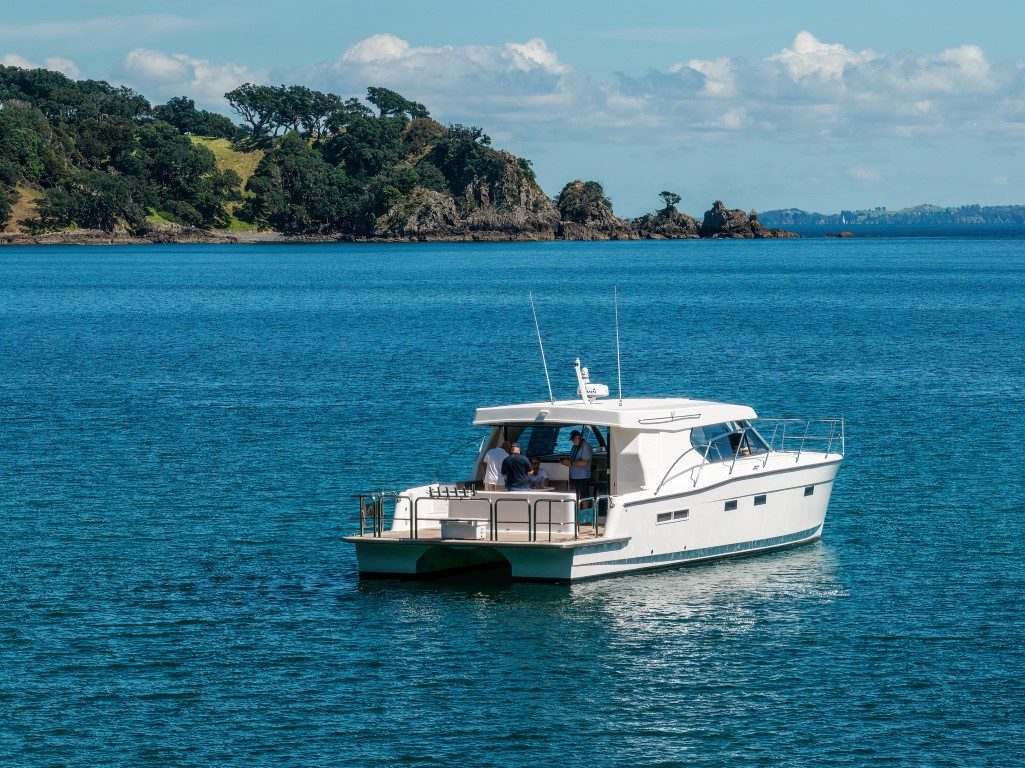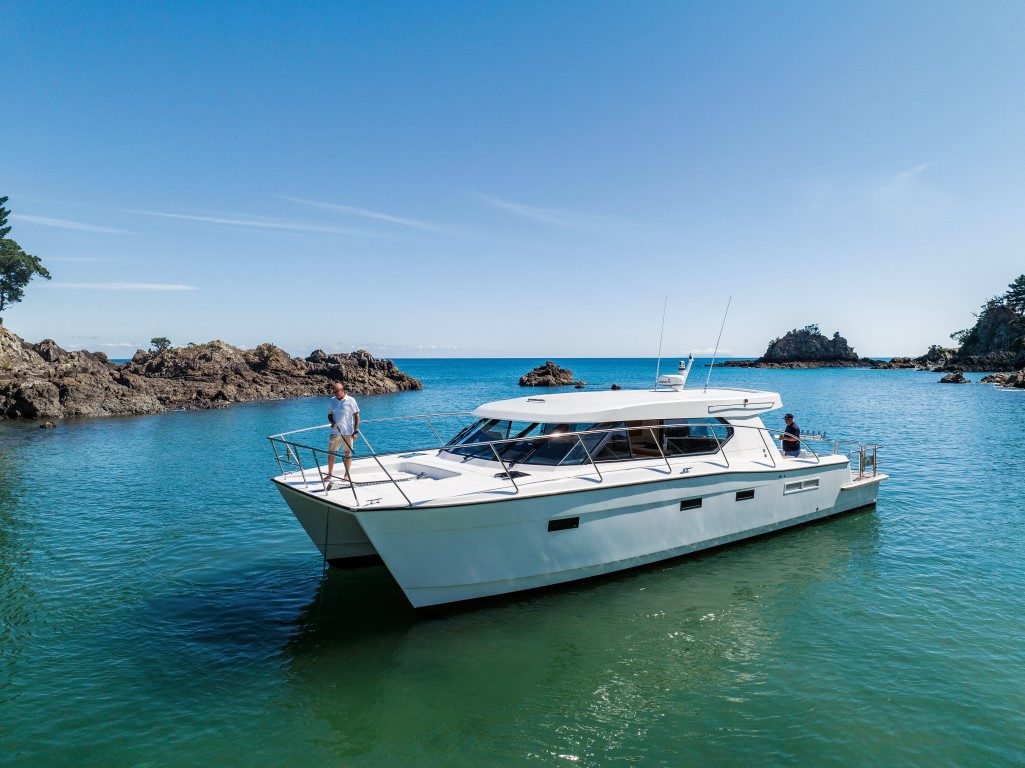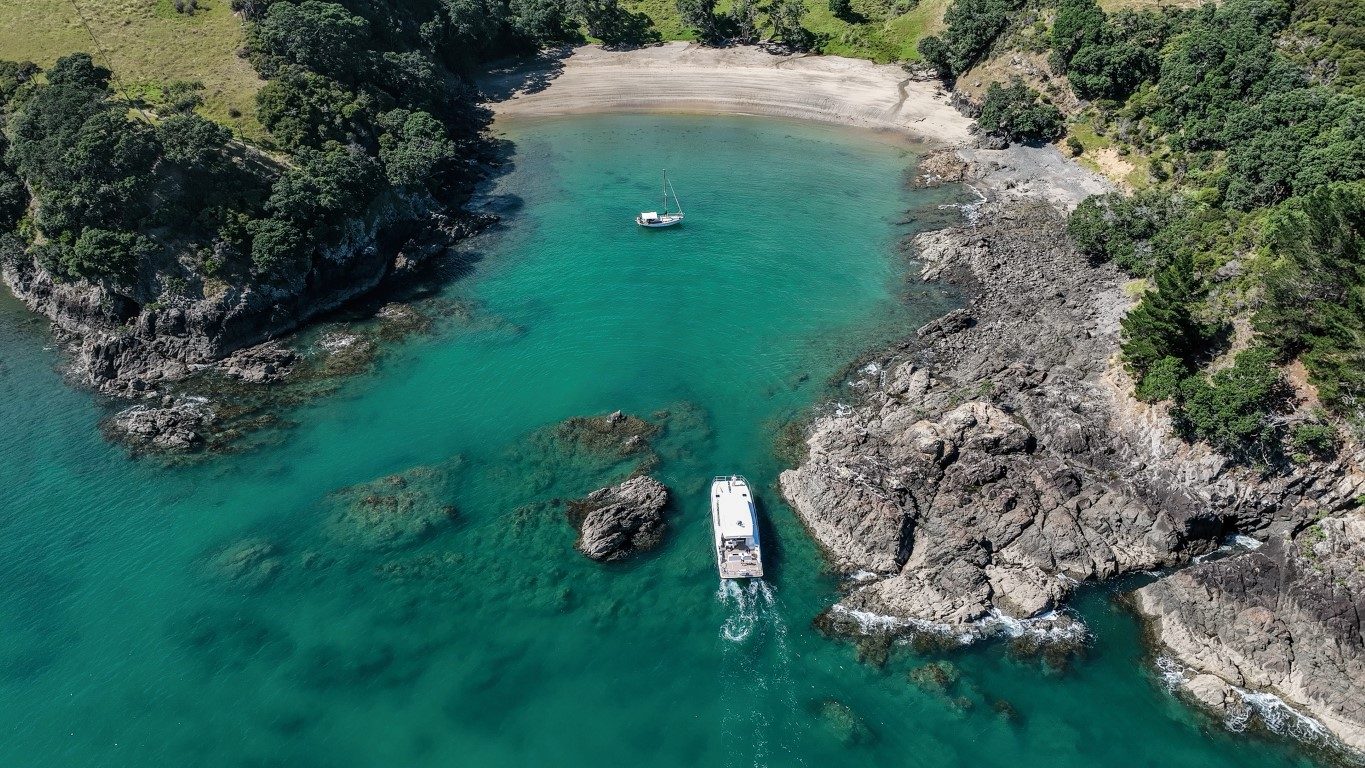‘Behemoth’ is a word which springs to mind or, perhaps more nautically, ‘leviathan’.
- Quality of cabins and interiors
- The ride
- Large single-level cockpit and saloon
- Low fuel consumption
Stepping onto the transom and into the cockpit of the Wright 52 is a boater’s dream: broad, deep, flat and safe.
The rear cockpit area is fisherman’s heaven and an entertainer’s delight – it is the perfect platform to spend as much time as possible living your dream.
The physics
Choosing a catamaran often comes down to aesthetics, and at times it should. It has been said that ‘cats don’t pound, they just ride soft’. But to ignore the physics of a power catamaran misses the point of a ‘cat’.
Catamarans have two slim hulls, pushing less water than a single deep-V hull. These slender hulls possess very different hydrodynamics compared to traditional monohull designs, with the catamaran being more ‘slippery’ (less wetted surface and therefore less water resistance), allowing it to run faster for a given amount of power.

These fundamental physics mean that the catamaran hull slices through the sea as its sharp edges enter a wave. This breaks up the waves and makes for a softer entry into a head sea. The same can be said in a quartering sea, too, with the bow of a catamaran entering the sea one sponson at a time, which splits the waves for a smoother entry and a gentle landing.
The Wright Effect
Catamarans are nothing new. They have been around since the first Pacific wayfinders started to explore the oceans.
Catamarans are wide, stable and lighter than an equivalent-length monohulls. The righting moment on a catamaran is greater than a V-hull, improving stability, and with the engines farther apart, cats are more maneuverable at low speeds, spinning easily.

There are reportedly over 2500 Wright-designed vessels on the water today. But when considering a new boat, it is hard to ignore the heritage that comes with any Alan Wright-designed vessel. Being one of New Zealand’s most popular keelboat designers, the Auckland-based Wright often ignored – or at the very least, stretched – conventional design boundaries and became renowned for creating slippery boats that were stable and seaworthy, as well as good-looking.
Wright’s power catamarans were even used in America’s Cup regattas to film the action, as they were so stable both at rest and underway while chasing the action.

However, some early power catamarans designs had a few inherent issues that made them uncomfortable to use. The largest and wettest of those issues is ‘hull sneeze’. This occurs when the boat comes down over a wave, and water pushes up against the tunnel between the two hulls and has nowhere to escape except out the front of the boat. The resulting ‘sneeze’ shoots water out front from under the bow and inevitably blows upwards to hit the windscreens. Riding on any boat with spray flying out from the bow isn’t fun.
Some catamarans can also get tricky in a following sea, digging in and tracking erratically. The two hulls don’t always like to run in a straight line. Then there’s turning. A deep-V hull boat leans inward in a turn, whereas a catamaran tends to lean outward. But there are ways to correct all these issues and accentuate the benefits, which this Alan Wright’s design has done very successfully.

The team behind K2 Marine, Kelvin and Amos Kay, are the proud owners of the moulds for this vessel. They are a father-and-son team that knows boats, with Kelvin being the bloke behind introducing the Thundercat class to New Zealand about 30 years ago.
During our on-the-water test of the Wright 52, it became clear that any challenges typically found in a power catamaran have been mitigated completely. The hull performance is very impressive.
The ride
The bow of the Wright 52 does not ‘jump out of the hole’ like a deep-V hull design. Instead, the semi-displacement vessel emerges from the water, feeling like it wants to fly. The hulls are designed so that trim tabs or interceptors are not required. The acceleration felt controlled whilst still pushing the skipper into the back of the helm seat. Whether accelerating from a standing start, or from a cruise speed of 18 knots to wide-open-throttle (28-29knots), which only took 11 seconds, conning the boat was fun and addictive.

The ride is brilliantly comfortable. There was no roll or high-siding when turning at speed. The propeller tunnels, matched with flat planing sections at the stern of both hulls providing significant lift, ensured excellent stability underway.
Twin Yanmar 550hp engines with four-bladed propellors quickly had the test boat planing efficiently at just 12 knots. On test day, we achieved over 29 knots; when the hull is clean, the hull and engine combination reportedly achieve just over 31knots.
The solid fibreglass and composite hulls’ efficiency is noteworthy. With a cruise speed of 21.7knots at 2300rpm, it uses just 64 litres per hour (total) with the engines running at just 66% of their maximum load.
Moving around
Catamarans are known for excellent close-quarter maneuvering. The Wright 52 is the perfect showcase for this feature. Fitting into most standard width single hull berths (yes, you read that correctly – a catamaran berth is not required for the Wright 52), the boat turns quickly with its twin engines, helped along by twin bow and twin stern thrusters.

So confident was Kelvin of the vessel’s manoeuvrability that we drove the Wright 52 through the very tight entrance to Garden Cove on Waiheke Island. This entrance has caught out many a skipper at high tide, let alone at low tide when we went through. Our safe passage was aided considerably by using a wireless remote-control unit that could move the boat in any direction using a mini joystick.
The ability to easily walk around the boat’s sides was a highlight, and the anchor locker is so large it is also where the fenders are stored.

Sheer comfort
The Wright 52’s interior exudes sheer comfort, usability, and Kiwi boat-building craft.
The rear cockpit is enormous and features a live-bait tank, freshwater sink, and a 49-litre Isotherm fridge. There are also two sizeable lazerette storage areas under the flooring and excellent access to the engines and electrical systems. The decks are teak-lined throughout.
To starboard of the main door is a full-sized day head that could easily accommodate a hot water shower. The cockpit overhang ceiling houses a large fishing rod locker which, when closed, is completely hidden. The rear window opens to connect interior and exterior dining spaces.

Clean lines and wide-open spaces are striking features inside the saloon. White oak with teak accents warms the vast space, making it feel homely and comfortable and the saloon’s dining table easily seats 5-6 adults, dropping down at the push of a button to make a double berth.
The galley features a gas hob and oven combination, dishwasher drawers that are easy to access, and forward of the galley is a retractable television connected to the Fusion stereo system.

The Wright 52 has all the latest electrical equipment, such as a 16-inch Garmin sounder/navigation screen, EBIRB, FLIR, radar and C-Zone. The twin chairs at the helm felt comfortable and spacious, providing excellent vision of the helm station, out of the windows and right around the boat.

A large bank of lithium batteries powers the vessel at rest, and there is a lot of space available to match these with a suite of solar panels.
The owner can customise the cabin and interior layout during the build phase – the test boat had a hand-stitched finish to the dashboard, for instance. This Wright design can accommodate a fully enclosed flybridge, creating even more space and versatility, as well as an electric davit system for the toys and tender.

Fit and finish
The test boat’s finish was excellent. The team at K2 has focused on soundproofing across all internal areas, which was evident on test day – we could talk normally whilst underway, despite all the windows being open. There was little engine or hull noise to speak of.
The port hull has a rear cabin with twin single berths, a forward double cabin, a well-appointed wet room, and a head and shower. The storage underneath the forward cabin is vast, and the storage forward of the cabin in the bow is also enormous. The black taps were a nice touch.

The starboard hull houses the very comfortable master cabin with a semi-island bed. It also has a master bathroom and wardrobe.
Living the dream
The Wright 52 is well appointed boat. The hull performance is excellent – a testament to those involved in her design and engineering set-up. The boat inspired confidence, at anchor and underway. Combined with the layout and top-quality finish throughout, the Wright 52 will make any owner feel like they are living the dream. On test day, tucked into the northeastern cliffs of Waiheke Island, we were asking ourselves whether we had time to nip over to Great Barrier Island for the afternoon. We didn’t, but the boat was keen!

‘Behemoth’ is a word which springs to mind or, perhaps more nautically, ‘leviathan’.
White Pointer has earned the respect of discerning customers in New Zealand and Australia, attracting a loyal and ever growing following for its high-quality, rugged and totally dependable aluminium trailer boats.
The hardtop SP635 shares the same underpinnings as the popular SF 635 which was a completely new model back in 2020.
The pride and joy of a multi-generational family, Bliss resides on a pier that’s home to a couple of other Elite motor launches – Sandspit Marina is a hot-spot for the Bill Upfold-designed vessels, with several calling this small marina home.